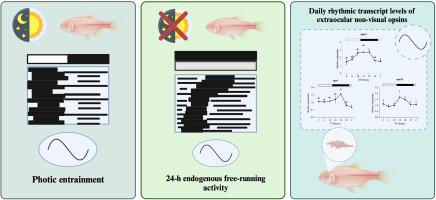墨西哥洞穴盲鱼(Astyanax mexicanus)大脑中运动活动的日节律和非视觉蛋白的转录水平。
IF 2.2
3区 生物学
Q4 BIOCHEMISTRY & MOLECULAR BIOLOGY
Comparative Biochemistry and Physiology A-Molecular & Integrative Physiology
Pub Date : 2024-11-04
DOI:10.1016/j.cbpa.2024.111772
引用次数: 0
摘要
大多数生物都有内源性昼夜节律钟,使其生理和行为与环境周期同步,其中光-暗(LD)周期是最有效的同步信号。因此,可以假设,在黑暗中进化的动物,如洞穴或深海中的动物,可能不再拥有功能性的光诱导生物钟。在这项研究中,我们选择了盲洞穴鱼Astyanax mexicanus作为模式生物,研究日常光照条件对昼夜节律计时机制的潜在影响。首先,我们通过记录不同光照条件下的运动活动节律,重点描述了行为光诱导和昼夜节律内生节律的存在:LD 12:12、LD 6 小时转换后、恒定黑暗 (DD) 和恒定暗光 (LLdim)。其次,我们利用实时定量 PCR 技术分析了该盲目物种大脑中部分非视觉眼外虹膜蛋白(exo-rhod、opn3、rgra、rgrb、tmt1a 和 tmt1b)的日表达节律,旨在确定光探测机制的特征。我们的研究结果表明,墨西哥洞穴盲鱼的活动节律与 LD 周期有关,在恒定光照条件下,其昼夜活动模式持续存在。此外,在所分析的六个非视觉视蛋白基因中,有三个基因(opn3、rgra 和 tmt1b)的日变化和/或节律在统计学上有显著意义,所有这些基因都显示出夜间渐缩现象。这些研究结果表明,视网膜外非视觉蛋白的日节律可能在传递日光周期,并有助于盲洞鱼种的运动活动和其他光同步节律的调节。本文章由计算机程序翻译,如有差异,请以英文原文为准。

Daily rhythms of locomotor activity and transcript levels of non-visual opsins in the brain of the blind Mexican cavefish (Astyanax mexicanus)
Most organisms possess endogenous circadian clocks that synchronise their physiology and behaviour with environmental cycles, with the light-dark (LD) cycle being the most potent synchronising signal. Consequently, it can be hypothesised that animals that have evolved in the dark, as in caves or deep sea, may no longer possess a functional light-entrained biological clock. In this research, the blind cavefish Astyanax mexicanus was selected as a model organism to investigate the potential effects of daily light conditions on the circadian timekeeping mechanisms. First, we focused on describing behavioural photic entrainment and the presence of a circadian endogenous rhythmicity by recording locomotor activity rhythms under different lighting regimes: LD 12:12, after a 6-h shift of LD, constant darkness (DD), and constant dim light (LLdim). Secondly, we aimed at characterising the mechanisms of photodetection by analysing the daily rhythms of expression of selected non-visual extraocular opsins (exo-rhod, opn3, rgra, rgrb, tmt1a and tmt1b) in the brain of this blind species using real-time quantitative PCR. Our results revealed that blind Mexican cavefish activity rhythms were entrained to the LD cycle, with a diurnal activity pattern that persisted in a circadian fashion under constant lighting conditions. Additionally, statistically significant daily variations and/or rhythms were observed in three out of the six non-visual opsin genes analysed (opn3, rgra and tmt1b), all of them displaying nocturnal acrophases. These findings suggest that daily rhythms in extraretinal non-visual opsins may be transducing daily photic cycles and contributing to the entrainment of locomotor activity and other light-synchronised rhythms in blind cavefish species.
求助全文
通过发布文献求助,成功后即可免费获取论文全文。
去求助
来源期刊
CiteScore
5.00
自引率
4.30%
发文量
155
审稿时长
3 months
期刊介绍:
Part A: Molecular & Integrative Physiology of Comparative Biochemistry and Physiology. This journal covers molecular, cellular, integrative, and ecological physiology. Topics include bioenergetics, circulation, development, excretion, ion regulation, endocrinology, neurobiology, nutrition, respiration, and thermal biology. Study on regulatory mechanisms at any level of organization such as signal transduction and cellular interaction and control of behavior are also published.

 求助内容:
求助内容: 应助结果提醒方式:
应助结果提醒方式:


